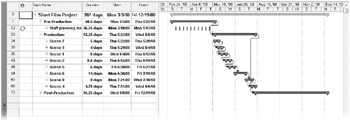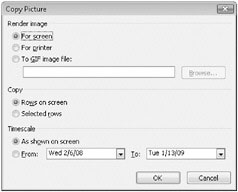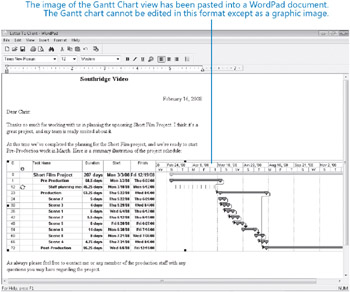Copying and Pasting with Project
You can copy and paste data to and from Project by clicking the Copy Cell, Paste, and Paste Special commands on the Edit menu and the Copy Picture command on the Report menu (or the corresponding buttons on the Standard toolbar). When copying data from Project, you can choose one of two options, depending on the results you want:
-
You can copy text (such as task names and dates) from a table and paste it as text into a destination program, such as Microsoft Office Word.
-
You can copy a graphic image of a view from Project and paste it as a graphic image in the destination program. With the Copy Picture command on the Report menu, you can create a graphic image of a view or a selected portion of a view. Use the Copy Picture feature to optimize the image for onscreen viewing (in PowerPoint, for example) or for printing (in Word, for example).
| Tip | The Copy Picture feature also includes an option to save the snapshot to a GIF image file. You can then include the GIF image in a Word document or e-mail message, or post it directly to an intranet site. |
There is an important distinction between using Copy Cell and Copy Picture. If you use Copy Cell, you can edit the data in the destination program. However, Copy Picture yields an image that you can edit only with a graphics editing program.
| Tip | Many Windows programs, such as Word and Excel, have a Paste Special feature. This feature provides you with more options for pasting data from Project into the destination program. For example, you can use the Paste Special feature in Word to paste formatted or unformatted text, a picture, or a Project Document Object (an OLE object). You can also choose to paste only the data or paste it with a link to the source data in Project. For more information about using OLE with Project, type Embed an object into Project into the Search box in the upper right corner of the Project window. The Search box initially contains the text Type a question for help. |
You also have two options when pasting data into Project from other programs:
-
You can paste text (such as a list of task or resource names) into a table in Project. For example, you can paste a range of cells from Excel or a sequence of paragraphs from Word into Project. You might paste a series of task names that are organized in a vertical column from Excel or Word into the Task Name column in Project, for instance.
-
You can paste a graphic image or an OLE object from another program into a graphical portion of a Gantt Chart view. You can also paste a graphic image or an OLE object into a task, resource, or assignment note; into a form view, such as the Task or Resource Form views; or into the header, footer, or legend of a view or report.
| Important | Pasting text as multiple columns into Project requires some planning. First, make sure that the order of the information in the source program matches the order of the columns in the Project table. You can either rearrange the data in the source program to match the column order in the Project table or vice versa. Second, make sure that the columns in the source program support the same types of data-text, numbers, dates, and so on-as do the columns in Project. |
For the short film project, you’d like to add a Gantt chart image to a document you’ve prepared for a stakeholder of the project. In this exercise, you copy a snapshot of a Gantt chart and paste it into Microsoft WordPad (or Word, if you prefer). You copy information in the same way regardless of the destination program you have in mind. For example, you could paste the snapshot into a word processor file or an e-mail message. To begin, you’ll format the Gantt Chart view to show the information you want.
In this exercise, you copy an image of a Gantt Chart view to the Windows Clipboard and then paste it into another document.
Be Sure To start Microsoft Office Project 2007 if it’s not already running.
| Important | If you are running Project Professional, you may need to make a one-time adjustment to use the Computer account and to work offline. This ensures that the practice files you work with in this chapter do not affect your Project Server data. For more information, see “Starting Project Professional” on page 11. |
Open Short Film Project 12a from the \Documents\Microsoft Press\Project 2007 SBS\ Chapter 12 Sharing folder. You can also access the practice files for this book by clicking Start, All Programs, Microsoft Press, Project 2007 Step by Step, and then selecting the chapter folder of the file you want to open.
1. On the File menu, click Save As.
The Save As dialog box appears.
2. In the File name box, type Short Film Project 12, and then click Save.
3. On the Project menu, point to Filtered For: All Tasks, and then click Summary Tasks.
Project displays only the summary tasks in the project.
4. On the View menu, click Zoom.
The Zoom dialog box appears.
5. In the Zoom dialog box, click Entire project, and then click OK.
Project adjusts the timescale of the Gantt chart to show the entire project.

6. On the Report menu, click Copy Picture.
| Tip | You can also click Copy Picture on the Standard toolbar. |
The Copy Picture dialog box appears.
7. Under the Render image label, make sure that For screen is selected.

8. Click OK.
Project copies a snapshot of the Gantt Chart view to the Clipboard.
Next, you’ll open a proposal document that’s been created in a word processor. You can open this in WordPad (as illustrated here) or in Word if you have it.
9. Do one of the following:
-
If you do not have Word installed, click the Windows Start button, point to All Programs, click Accessories, and then click WordPad.
-
If you have Word installed, start it.
10. Do one of the following:
-
In WordPad or Word 2003 or earlier, on the File menu, click Open.
-
In Word 2007, click the Microsoft Office button, and then click Open.
11. Locate and open the document named Letter To Client in your Chapter 12 Sharing folder (you may have to select All Files in the Files of type box).
12. Once the document has opened, select the paragraph (insert Gantt Chart picture here).
13. Press ![]() .
.
Project pastes the snapshot of the Gantt Chart view from the Clipboard to the document.

Again, note that rather than pasting the image into a Word or WordPad document, you could paste this image into an e-mail message or another type of document.
14. Do one of the following:
-
On the WordPad or Word 2003 or earlier File menu, click Exit.
-
In Word 2007, click the Microsoft Office button, and then click Exit Word.
15. When prompted to save the document, click No or Don’t Save.
EAN: 2147483647
Pages: 247